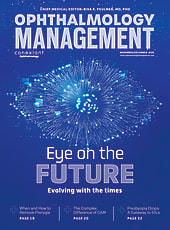Standard operating procedures (SOPs) are critical tools in clinical settings. They help ensure patient care is safe, consistent, and efficient. By following SOPs, clinical staff can reduce the risk of errors, improve diagnostic accuracy and efficiency, and provide care that aligns with best practices.
SOPs also support smoother workflows. They help teams use time, equipment, and supplies more effectively, which is especially important in busy health care environments. When everyone follows the same procedures, it reduces confusion and helps the team work together more efficiently.
Clear SOPs also improve communication. They make sure all team members understand their roles and responsibilities, which builds trust and reduces mistakes caused by miscommunication. In short, SOPs help clinical teams deliver high-quality care with confidence and consistency.
SOPs and the Comprehensive Eye Exam Workup
All areas of the practice can benefit from standardized procedures. In an eyecare practice, the clinical team is well supported by standardized procedures. Consider the comprehensive eye exam workup. Certain history elements can be standardized to prompt appropriate patient questions, including “if this, then ask that” protocols to ensure thorough history taking. Standardized exam elements are also required for comprehensive eye code documentation (ie, muscle balance evaluation, confrontation visual fields, etc).
SOPs and Test Performance
Test performance is another clinical area where standardized operating procedures shine. There are valuable, nonbillable tests, such as glare testing, etc, that can be standardized for performance in scenarios of glare complaints, for example. Valuable patient and staff time is wasted when glare testing is performed in the absence of a patient complaint.
Have you ever seen a physician frustrated by poor lens correction or test artifacts in a visual field, requiring a retest—or worse, delaying care until the next annual exam? What clinical information could be missed and cause a care delay for the patient in the latter scenario?
Standardized, step-by-step protocols on how to perform tests ensure that test and examination procedures are done correctly and efficiently each time. Since the SOP itself is a reference for staff, it eliminates the need to flag down the most experienced tech for questions or worse—allow newer staff’s questions to go unanswered.
SOPs and Training/Retaining Staff
SOPs are also key in supporting employee training and retraining staff for any type of patient care visit, testing, and for supportive job responsibilities. All techs have supportive job responsibilities, including stocking rooms, triaging patient calls, medication refills, and secure messaging with patients, such as delivering test results and educational information.
Conclusion
In summary, making SOP development a priority in your clinic will lead to smoother operations, greater accuracy, and stronger support for physicians. The best way to begin? Start with the very next question you’re asked; if it’s something that could be answered by a standard process, that’s the first SOP you and your team can build.
As you build these one by one, they’ll become valuable tools for training, daily reference, and improving how work gets done. Over time, you’ll see meaningful improvements in efficiency, teamwork, and patient care—one SOP at a time. OP









